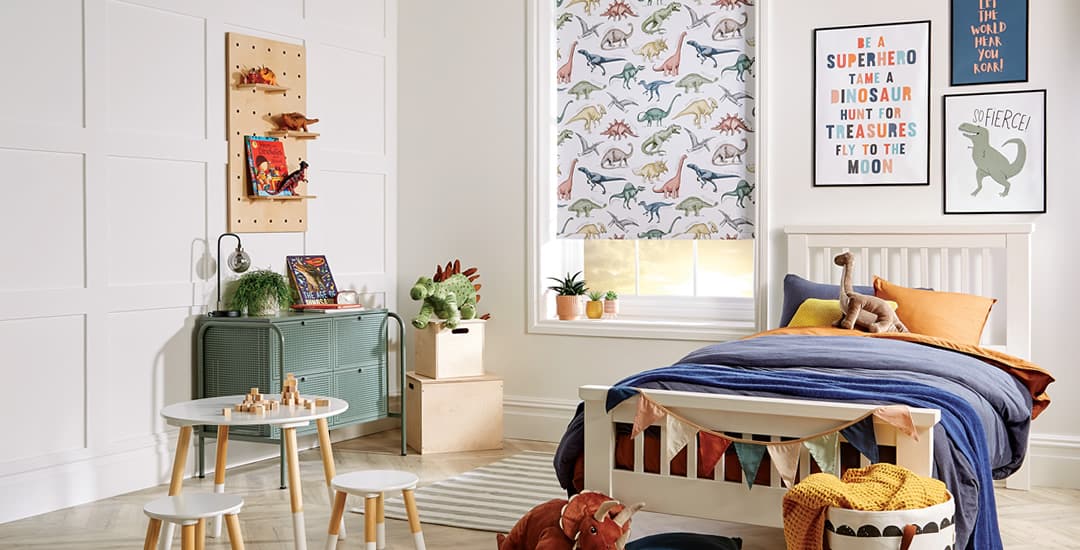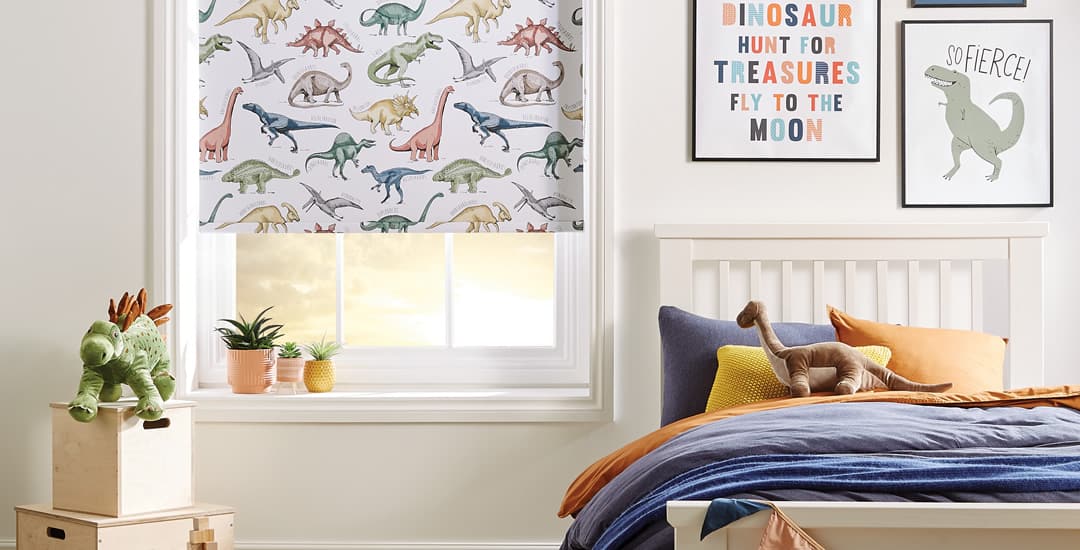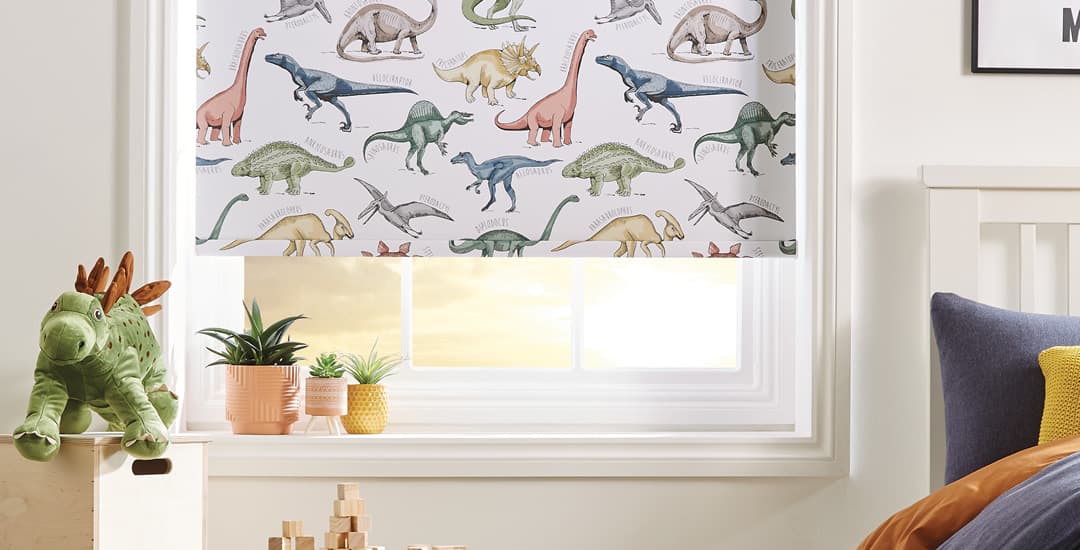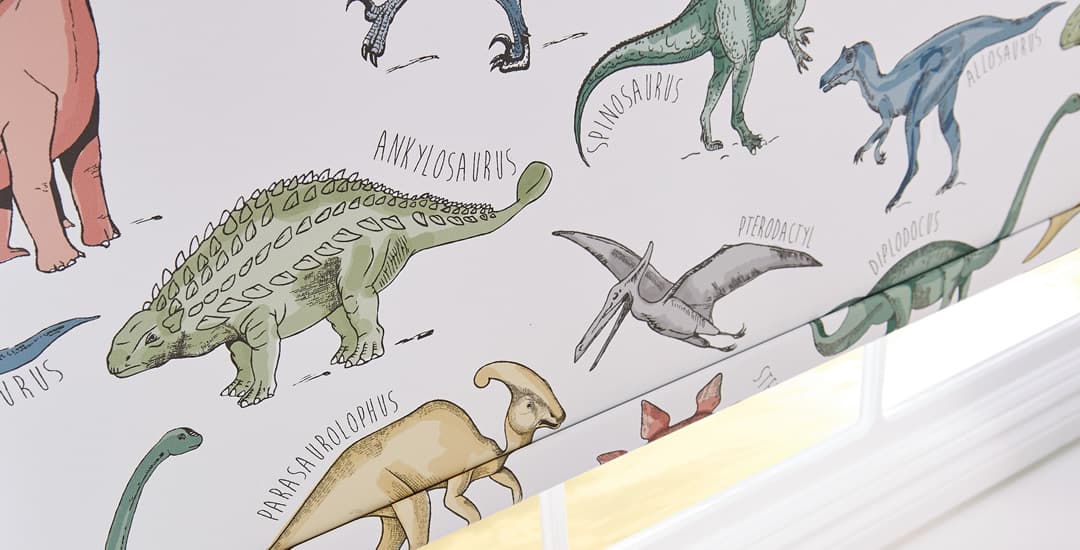
If you’re looking for blinds for a child’s bedroom, there are masses of options for types, colours, and designs; many made specifically with children in mind. These should appeal to your child’s interests and imagination, which will hopefully ensure that they treat said blind with a reasonable degree of respect in operation because they don’t want to ruin it!
In terms of blinds for children, dinosaur blinds are reliably in the top three most popular options we sell at any given time; factoring in the likelihood that there’s the odd adult who is enough into dinosaurs to pick up a set too.
Why are they so popular then, and why choose dinosaur window blinds for your child’s bedroom? I’ll tell you in this blog post, as well as outlining what type of blinds dinosaur blinds actually are (or can be), and covering the ever-important child safety information you need to know when buying blinds too.
Read on to learn everything you ever wanted to know about dinosaur window blinds; including of course, which dinosaurs star in our own dinosaur blinds for children.
What type of blinds are children’s dinosaur blinds?

Starting with the basics then, what are dinosaur blinds? I’m more or less assuming that you get that I’m referring to the design on said blinds when I talk about dinosaur blinds, rather than thinking that “dinosaur blinds” might actually be a model or type of blinds in its own right.
It’s not, albeit I have seen some sets of blinds that certainly looked old enough to have been around back when roaring stuff roamed the earth and Fred Flintstone was president.
Basically, dinosaur blinds are almost always roller blinds; with the dinosaurs forming the print on the blind’s fabric. Theoretically, Roman blinds could be made from a dinosaur fabric too, because this is the other type of blind that can carry a design.
However, it’s fairly unlikely that you’d find dinosaur Roman blinds on offer anywhere, because Roman blinds are widely considered to be the most prestigious/luxurious type of blinds on the market, and are priced to match. This is usually something that folk don’t deem to be a good investment when created from a novelty fabric and hung in a room where The Minions and Buzz Lightyear are likely to form the main part of their audience.
Are dinosaur blinds for children educational?
For me, the “why choose dinosaur blinds for your child’s bedroom” question is kind of a no-brainer. I have never met a kid that didn’t like dinosaurs, or at least, none that were not inadvertently traumatised at a young age by creeping downstairs after bedtime to watch Jurassic Park.
Dinosaur-everything is all over kid’s TV; my next-door neighbour is five (should probably mention that adults live with him too) and I’m pretty sure that he got into dinosaurs somewhere between the ages of two and three, and his enthusiasm for them hasn’t waned since.
I’m advised that Andy’s Dinosaur Adventures is the show to watch on CBeebies… But anyway, if you’re here for dinosaur blinds, you probably know that already.
Dinosaurs certainly seem to spark the imagination of children of all ages, and obviously, assuming that your source of dino wisdom is indeed Andy’s Dinosaur Adventures or similar and not Jeff Goldblum, it helps to form one of the very foundational building blocks of their education too.
Some of the things that children begin to learn about when they learn about dinosaurs include natural history, evolution, environmental issues, biology, the passage of time, diet, nutrition, and food chains; and learning about dinosaurs even helps to broach or introduce harder, more complex real-life topics such as death/extinction too.
Obviously, some of these topics (such as death, extinction, and environmental issues) are designed to be introduced in detail to rather older children, but I do think that even if your child is at the age/level of dinosaur obsession that extends no further than hitting you with a plastic Pterodactyl while making roaring sounds, they are learning something, if only exactly where your patience threshold tops out.
I am also pretty sure, based on my sample size of exactly one child (Archie next door) that his first complex word/attempt at mastering scientific terminology was a dinosaur name, and believe me, having heard him mangling and finally mastering terms like Brontosaurus both verbally and in the language of fridge magnets, I feel qualified to say that his love of dinosaurs also helped him to develop his language skills and spelling too.
Why choose dinosaur blinds for your child’s bedroom?

I feel like I’ve just done a sterling PR job for the dinosaurs themselves there; why choose dinosaur window blinds though?
As I did mention in my essay above, they’re both educational and apt to spark the imagination of children, plus they obviously fit into a dinosaur-themed bedroom or a bedroom in which dinosaurs feature heavily.
Kids more of less universally love dinosaur blinds, assuming that they’re into dinosaurs in general; and in my experience, this means they’re far less likely to try to involve the blind in swordfights or otherwise do anything that might potentially damage it. They may even be keen (this being relative when it comes to children) to preserve and treat it with reasonable care and attention when they reach an age at which they’re tall enough and responsible enough to be able to operate the blind themselves.
Another good point to note about dinosaur roller blinds is that roller blinds are an economical purchase, as they are almost always the lowest cost type of window blinds you can buy. This is often an important consideration for parents, and if the blind does get ruined over time by sticky hands and flying spaghetti, it’s not the end of the world.
Oh, also, dinosaur blinds block out external light, allowing your child to sleep (hopefully), and also ensuring that Fungus the Bogeyman can’t see in when they do.
Our own dinosaur blinds are blackout blinds, and their blackout lining consists of a special material that is thermally efficient, meaning that it helps to insulate the window that it’s on, which can actually help to reduce your heating bills as well.
Are dinosaur blinds child safe?
Given that dinosaur blinds are specifically made for children (or more accurately, we kind of assume that under-16s make up the greater part of our pool of end users of such blinds) one would hope that it goes without saying that dinosaur blinds are child safe.
I’ll say it anyway; they are. Also, plot twist, every blind we sell (and every blind legally sold in the UK, if you want to be pedantic) is child safe too; there’s a law dictating this and everything.
Our dinosaur roller blinds comply with/exceed the relevant Child Safety Directives and standards, with EN13120 (the child safety requirements for internal blinds) being the main one.
This means that our dinosaur blinds are fitted with a sidewinder control chain that features an easy-break connector, so that if greater-than-average pressure is placed on it (such as if your child decided to see how well it worked as a noose, for instance, if you have a lemming in the family) the breakaway would come apart, breaking the loop and ruining your child’s game potentially saving your child’s life.
Window blind child safety does depend somewhat on you as the fitter of said blind as well as us as the seller of it, by the way; you should ensure that the cord/chain is kept short enough to avoid it forming an unnecessarily big loop, and/or that you use a cleat or P-clip (supplied with your blind where relevant) to keep any excess of chain out of the way.
If/when the breakaway in the chain breaks, this isn’t the end of the line for the blind; you just need to clip it back in place to restore the blind to full function.
Tell me more about the dinosaurs…

So, now that the parents/purse string holders are catered for, onto the important bit: What kind of dinosaurs can be found on dinosaur blinds anyway?
On our own dinosaur blackout roller blinds, you can find all of the usual suspects, being:
- Tyrannosaurus rex.
- Brontosaurus.
- Stegosaurus.
- Velociraptor.
- Pterodactyl.
- Triceratops (this one is my fave).
- Diplodocus.
- Parasaurolophus (had to look this one up, pretty sure he hadn’t actually been discovered when I was a child).
- Ankylosaurus (same).
Also, it may be worth noting that our best-selling dinosaur blind has a neutral background with the dinosaurs in blue, red, green, grey, and yellow/beige, ensuring that it fits with more or less any colour scheme. That said, most of the parents I know kind of laughed when I suggested that their kid’s lairs had a colour scheme, one telling me that “this is only relevant if the carpet can actually be seen under all the toys.”
Oh, and the name of each dinosaur is printed next to it too (and yes, I am OCD enough that I went and reviewed these for both spelling and correct word/creature pairing before I went out on a limb here), helping your child to learn the correct name for the correct dino, as well as its correct spelling.
If you have high hopes of your child enjoying a future career as a palaeontologist or if this is the direction they themselves look to be heading in (even if you have some misgivings about the impact this may have on their social skills thanks to Ross from “Friends”) dinosaur blinds are clearly a must-have.
I’m reaching a little bit now, aren’t I.




